 W
WThe CZ series is a family of low-cost phase distortion synthesizers produced by Casio in the mid-1980s. Eight models of CZ synthesizers were released: the CZ-101, CZ-230S, CZ-1000, CZ-2000S, CZ-2600S, CZ-3000, CZ-5000, and the CZ-1. Additionally, the home-keyboard model CT-6500 used 48 phase distortion presets from the CZ line. The CZ synthesizers' price at the time of their introduction made programmable synthesizers affordable enough to be purchased by garage bands. Yamaha soon introduced their own low-cost digital synthesizers, including the DX-21 (1985) and Yamaha DX100, in light of the CZ series' success.
 W
WThe VL-1 was the first instrument of Casio's VL-Tone product line, and is sometimes referred to as the VL-Tone. It combined a calculator, a monophonic synthesizer, and sequencer. Released in June 1979, it was the first commercial digital synthesizer, selling for $69.95.
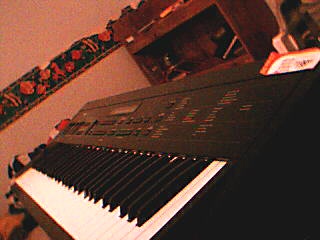 W
WThe Korg DS-8 is an expandable FM synthesizer released by KORG in 1986 which used the Yamaha FB-01 FM synthesis engine with 4 sine wave oscillators. 61 Keys in length with both initial and switchable aftertouch capabilities it stores up to 100 programs and 10 combinations in its internal memory. By using one of the optional non-volatile KORG RAM cards MCR-01, MCR-02, or MCR-03 this program memory can be expanded by extra programs and combinations: 100/10 for the MCR-01, 200/20 for the MCR-02, or 400/40 for the MCR-03. Programs can be backed up and received via standard MIDI dumps.
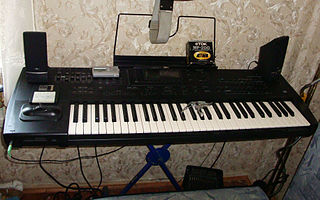 W
WThe Korg i3 is a keyboard instrument introduced by Korg in 1993. Known as an "Interactive Music Workstation", the i3 broke new ground for Korg, and defined a new type of instrument - the professional auto-accompaniment workstation. Contrary to popular belief, it was not Korg's first foray into the realm of auto-accompaniment - it had a minor hit in 1985 with the SAS-20, a home keyboard with built-in speakers.
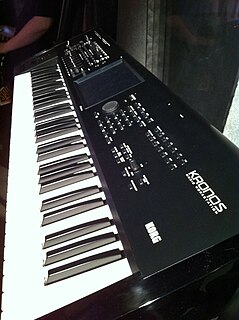 W
WThe Kronos is a music workstation manufactured by Korg that combines nine different synthesizer sound engines with a sequencer, digital recorder, effects, a color touchscreen display and a keyboard. Korg's latest flagship synthesizer series at the time of its announcement, the Kronos series was announced at the winter NAMM Show in Anaheim, California in January 2011.
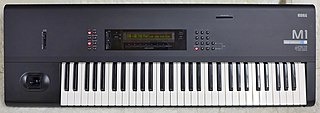 W
WThe Korg M1 is a synthesizer and music workstation manufactured by Korg from 1988 to 1995. It became the top-selling digital synthesizer of its time.
 W
WThe Korg Minilogue is a two VCO per-voice, four-voice, polyphonic analog synthesizer from Korg, designed by Korg engineer and synthesizer designer Tatsuya Takahashi. It was announced just prior to NAMM 2016, and is priced new at $499.99 in the United States, ¥55,000 in Japan and £449 in the United Kingdom and Europe. Its official release was preceded by leaks which caused media speculation.
 W
WThe Korg MS2000 is a virtual analog synthesizer produced by the Japanese electronic musical instrument manufacturer Korg.
 W
WThe Korg X3 is a music workstation produced by Korg in 1993. The X3 features 200 programs, 200 combinations, 32-voice polyphony, a 32,000 note, 16-track sequencer with 100 patterns and 10 songs and a double-sided, double-density 3.5-inch floppy disk drive for song and other data storage types. Korg also released the X2 (76-key) with 8 Mbyte ROM in 1994 along with a rackmount version dubbed the X3R, which also had a floppy disk drive.
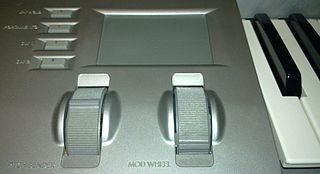 W
WThe Korg Z1 is a physical modelling sound synthesiser released in 1997. Touted as a polyphonic Prophecy, the Z1 implements 13 synthesis types, all derived from the original OASYS synthesizer.
 W
WThe Kurzweil K2000 is a digital synthesizer and music workstation produced by Kurzweil Music Systems between 1991 and 2003 in a variety of standard configurations, including rack-mountable versions and models that came with 16-bit user sampling.
The Roland AX-7 is a keytar that was manufactured by Roland Corporation from 2001 to 2007. This modern instrument contains many more advanced features than early keytars such as its predecessor, the Roland AX-1, and the Yamaha SHS-10. It runs on 6 AA batteries or an external power source. It has a 45 velocity sensitive keys, and a 3-character LED display. Several features aimed towards stage performance are present, such as a pitch bend ribbon, touchpad-like expression bar, sustain switch, and volume control knob, all on the upper neck of the instrument. There is also a proprietary "D-Beam" interface, made up of infrared sensors that detect nearby motion.
 W
WThe Roland AX-Synth is a keytar that is manufactured by Roland Corporation, and was released in late August 2009. This modernized instrument builds on the features of its predecessor, the Roland AX-7. The most notable change is the addition of an internal synthesizer. A UV Black-colored "premium" model called "Black Sparkle" was released in September 2010. The AX-Synth has now been discontinued as well.
 W
WThe Roland D-50 is a synthesizer produced by Roland and released in April 1987. Its features include subtractive synthesis, on-board effects, a joystick for data manipulation, and an analogue synthesis-styled layout design. The external Roland PG-1000 (1987-1990) programmer could also be attached to the D-50 for more complex manipulation of its sounds. It was also produced in a rack-mount variant design, the D-550 (1987-1990), with almost 450 user-adjustable parameters.
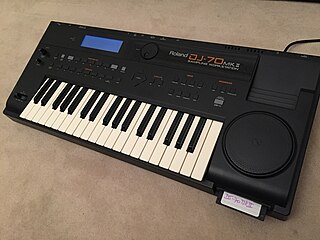 W
WThe Roland DJ-70 is a 16-bit linear A/D Conversion & 20-bit linear D/A Conversion sampling workstation and was released in 1992 by Roland Italy.
 W
WThe Roland E-20 is a keyboard instrument introduced by Roland in 1988.
 W
WThe Roland JD-800 is a digital synthesizer that was manufactured between 1991 and 1996. It features many knobs and sliders for patch editing and performance control — features that some manufacturers, including Roland, had been omitting in the name of streamlining since the inception of the Yamaha DX7. The JD-800 thus became very popular with musicians who wished to take a hands-on approach to patch programming. The introduction in the manual states that Roland's intention with the JD-800 was to "return to the roots of synthesis".
 W
WThe Roland JD-XA is a hybrid analog and digital synthesizer that was released in 2015, it is Roland's first analog polyphonic synthesizer since 1986. The instrument is encased by a shiny black front panel covered with knobs and sliders reminiscent of the Roland JD-800. The JD-XA comprises a 4 voice analog engine and a 64 voice digital engine, which can be used interactively or independently, thus providing a flexible platform for sound design.
 W
WThe Roland JP-8000 is an analog modeling synthesizer released by the Roland Corporation in 1996.
 W
WRoland Juno-G is a music workstation/synth introduced in 2006 by Roland Corporation. It is based on the Fantom-X series, having a vintage design that resembles the first Juno synthesizers, such as the Juno-106. The Juno-G's main competitors in the approximate price range, with similar features, when first released, were the Korg Triton Le/TR and Yamaha MO6 workstation synthesizers.
 W
WThe Roland U-20 is a PCM-sample synthesizer, released by Roland in 1988.
 W
WThe Roland XP-30 is a 61-key, 64-voice expandable synthesizer. Released in 1999, it was produced until 2002. Based on the acclaimed mid-90s JV sound engine built around a 32-bit RISC processor, it is considered to be the best value-for-money of all of the Roland JV and XP series synthesizers.
 W
WThe Roland XP-50 is a music workstation that combines the synthesizer engine of Roland's JV-1080 sound module with the sequencing capabilities of their MRC-Pro sequencer and a 61-note keyboard. First released in 1995, the XP-50 and the Roland XP-10 were the first two Roland XP-series products, later joined by the XP-80 and XP-30.
 W
WThe Roland XP-80 is a music workstation that uses digital PCM subtractive synthesis and combines an updated version of the JV-1080 synthesizer engine with the sequencer capabilities of the Roland MRC-Pro sequencer. The XP-80 was introduced in 1996 and is now discontinued.
 W
WThe Studio 440 was a sampler, sequencer, and 32 sound drum machine manufactured by Dave Smith's Sequential Circuits (SCI) and released in 1986. The sampler's core is similar to that of the Prophet 2000 and Prophet 2002. There is a 3.5" floppy disk drive to store samples and data.
 W
WThe Synclavier was an early digital synthesizer, polyphonic digital sampling system, and music workstation manufactured by New England Digital Corporation of Norwich, Vermont. It was produced in various forms from the late 1970s into the early 1990s. The instrument has been used by prominent musicians.
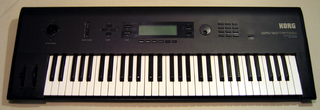 W
WThe Korg Wavestation is a vector synthesis synthesizer first produced in the early 1990s and later re-released as a software synthesizer in 2004. Its primary innovation was Wave Sequencing, a method of multi-timbral sound generation in which different PCM waveform data are played successively, resulting in continuously evolving sounds. The Wavestation's "Advanced Vector Synthesis" sound architecture resembled early vector synths such as the Sequential Circuits Prophet VS.
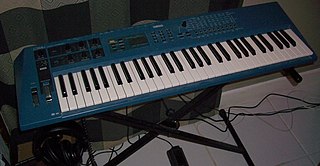 W
WThe Yamaha CS1x is a sample-based synthesizer released by the Yamaha Corporation in 1996.
 W
WThe Yamaha CS2x is a sample-based synthesizer released by the Yamaha Corporation in 1999. The CS2x is designed for maximum real-time control, according to Yamaha. It is the successor of the very successful Yamaha CS1x. Enhancements include 64-note polyphony, a bigger sample ROM and a 24 dB/oct LPF/HPF filter. The CS acronym stands for Control Synthesizer.
 W
WThe Yamaha DX1 is the top-level member of Yamaha's prolific DX series of FM synthesizers.
 W
WThe Yamaha DX7 is a synthesizer manufactured by the Yamaha Corporation from 1983 to 1989. It was the first successful digital synthesizer and is one of the best-selling synthesizers in history, selling over 200,000 units.
 W
WThe Yamaha DX21 is a digital bi-timbral programmable algorithm synthesizer with a four operator synth voice generator which was released in 1985. It uses sine wave-based Frequency Modulation (FM) synthesis. It has two FM tone generators and a 32-voice Random Access Memory (RAM), 32 user voices and 128 Read Only Memory (ROM) factory preset sounds. As a programmable synth, it enables users to create their own unique synthesized tones and sound effects by using the algorithms and oscillators. The instrument weighs 8 kg (17.6 lbs). On its release, it sold for $795.
 W
WThe Yamaha Motif is a series of music workstation synthesizers, first released by Yamaha Corporation in August 2001. The Motif replaced the EX series in Yamaha's line-up. Other workstations in the same class are the Korg Kronos and the Roland Fantom G. The series' successor is Yamaha Montage.
 W
WThe Yamaha PSR-E323, also known as the YPT-320, is an electronic keyboard manufactured by the Yamaha Corporation in 2009. It is a basic home keyboard intended for learning and personal use.
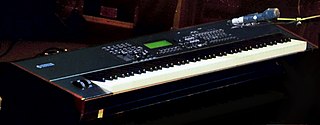 W
WThe Yamaha Music Synthesizer S90 is a synthesizer and a MIDI controller in one unit, released in 2002 to supersede the S80. As such, it is part of the S series together with the S03 and S08. It was superseded by the S90ES in 2005, itself superseded by the S90XS in 2009.
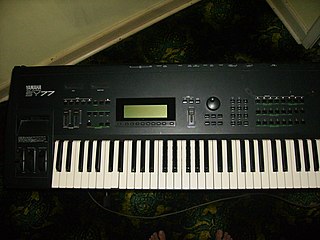 W
WYamaha SY77 is a 16 voice multitimbral music workstation first produced by Yamaha Corporation in 1989. The SY77 is a synthesizer whose architecture combines AFM synthesis, AWM2 for ROM-borne sample-based synthesis, and the combination of these two methods christened Realtime Convolution and Modulation Synthesis (RCM). The same technology was also packaged in a rack-mounted module released simultaneously, the TG77.
 W
WYamaha TG77 is the rack-mounted equivalent of Yamaha Corporation's SY77 synthesizer workstation. It, too, is a 16-voice multitimbral music (synthesizer) utilizing Yamaha's Advanced Frequency Modulation; Advanced Wave Memory; and the combination of these two systems, either by layering together or by modulating an AFM voice by an AWM wave, a synergy termed Realtime Convolution and Modulation Synthesis (RCM). The unit came into production in 1989, simultaneously with the SY77.
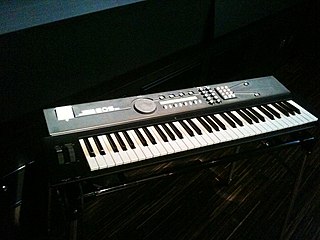 W
WThe Yamaha YS200 is an FM synthesiser and workstation produced by Yamaha, introduced in 1988. It combines a sequencer, rhythm machine, a FM synthesis soundchip and a MIDI keyboard. It was called the EOS YS200 in Japan and was also released as a more home-oriented keyboard in the form of the Yamaha EOS B200, which also featured built-in stereo speakers. The YS200 is the keyboard equivalent of the Yamaha TQ5 module. The forerunner of the YS200 was the almost-identical Yamaha YS100.